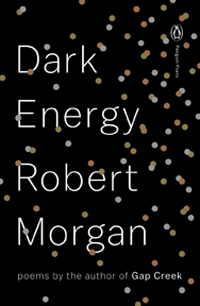The Forces that Bind Us
Robert Morgan’s new poetry collection, Dark Energy, fuses the lyric and the scientific
From the haze of the Blue Ridge Mountains to the glow of the Milky Way, Robert Morgan’s fifteenth collection of poetry illuminates both the invisible and observable forces that bind us, be they heritage or neutrinos, history or noble metals. In Dark Energy, Morgan—the New York Times-bestselling author of Gap Creek and other celebrated books of history and fiction—continues his exploration of two lifelong interests: the wonders of Appalachia and the fascinations of modern science. The result is a finely detailed, sonically-driven collection that reveals connections between the viewer and the viewed.
 Morgan’s inquiry into the scientific creates a sort of pastoral alchemy that helps assuage our neurotic obsession with the moment (both the frenetic gathering of knowledge via email, news, and celebrity gossip; and the recording of the present through selfies, Instagram, and Twitter). This fascination with the present moment too often precludes a sense of stewardship regarding the future, a tendency we see in climate-change denial and the overharvesting of natural resources.
Morgan’s inquiry into the scientific creates a sort of pastoral alchemy that helps assuage our neurotic obsession with the moment (both the frenetic gathering of knowledge via email, news, and celebrity gossip; and the recording of the present through selfies, Instagram, and Twitter). This fascination with the present moment too often precludes a sense of stewardship regarding the future, a tendency we see in climate-change denial and the overharvesting of natural resources.
Morgan, however, has invested his career in creating what he has called “a community across time.” This continual slide between past and present is particularly clear in “History,” which details the layers of the past that are revealed “Where cloudbursts tore a gash / in the shoulder of the ridge, / uprooting ferns and hedge.” What was hidden now emerges: “mica, groundhog den, / a zone of luminous clay” and, most surprising of all, “a shining /coin of the Spanish king” from 500 years ago.
Other poems also create a new way of looking at the present by harnessing legend with paleontology. In “Jaguar,” Morgan documents his own mistake in refusing to believe old reports of tigers in Appalachia:
They named the Tyger River, built
a town called Tigerville. Turns out
they told the truth: the leopards they
recorded were inhabitants
and natives to these mountain heights,
had golden hair and spots and faces
like tigers of the Old World tales….
The basic concerns of a lyricist tend to be structure, syntax, and linguistic play, all of which act in concert to reveal a mind alone with itself. Thus it is difficult for a lyric poem to convey scientific, historical, or other forms of curated information, but in Dark Energy Morgan addresses topics as varied as carpet tacking, periodic tables, MRIs, engines, and outer space. His solution to the seeming mismatch between genre and subject is to process information through his various forms of ken: emotional, familial, and scientific. (Morgan studied engineering at North Carolina State University.) In other words, his scientific inquiries are also his personal inquiries, resulting in lyrical poems that shimmer with a rational reverence for the physical world.
 Morgan’s dual concern with creating community and addressing science results in an interesting intersection with form. Both the biologist and the poet place a premium on observation and—when possible—try to uncover inherent patterns and forms, from the beehive hexagon (with equal sides and angles, all 120 degrees) to the sonnet’s line unit. In his essay “Lattice Work: Formal Tendencies in the Poetry of Robert Morgan and Ron Rash,” Johnson City poet Jesse Graves describes Morgan’s lines as broken down “into its smallest particle.” Just as a chemist might break down a complex system into its basic molecules, Morgan will consider a poetic line in terms of its smallest part: the syllable. And his preference for formal poetry—primarily, in this book, iambic tetrameter—serves to reinforce community. As Graves explains, “Part of the living past of poetry is structural and aural regularity, the continuity of sound patterns and visual recognitions, thus creating a bond and an agreement between the poet and the reader.”
Morgan’s dual concern with creating community and addressing science results in an interesting intersection with form. Both the biologist and the poet place a premium on observation and—when possible—try to uncover inherent patterns and forms, from the beehive hexagon (with equal sides and angles, all 120 degrees) to the sonnet’s line unit. In his essay “Lattice Work: Formal Tendencies in the Poetry of Robert Morgan and Ron Rash,” Johnson City poet Jesse Graves describes Morgan’s lines as broken down “into its smallest particle.” Just as a chemist might break down a complex system into its basic molecules, Morgan will consider a poetic line in terms of its smallest part: the syllable. And his preference for formal poetry—primarily, in this book, iambic tetrameter—serves to reinforce community. As Graves explains, “Part of the living past of poetry is structural and aural regularity, the continuity of sound patterns and visual recognitions, thus creating a bond and an agreement between the poet and the reader.”
The final and perhaps the strongest section of the book directly confronts the unfolding realities of our universe. With titles such as “Periodic Table,” “Algae,” “Dark Matter,” “Engine,” “MRI,” and of course, “Dark Energy,” readers instantly understand the focus of each poem, even if the subject might not be the usual stuff of poetry. But Morgan is aware of the need for definitions: in “Coriolis Effect,” for example, he explains the title’s concept: “Because the earth is made to spin / and tilted on its axis, none / can fall or travel in a line.” Here the scientific subject reaches poetry’s audience in seemingly colloquial language that is actually written in strict iambic patterns augmented by slick slant rhymes (spin, none, line). Even when it feels as if he is simply explaining a scientific concept, he does so using the tools of poetry.
As the book closes, what Morgan has hinted at in many poems is now fully articulated: despite our accumulating knowledge, mystery remains: “That what we know is just / a fraction of what is / is nothing new” he writes in “Dark Matter.” As the penultimate poem, “Dark Energy” marvels at the hidden forces that govern our natural world, it simultaneously insists that we accept humanity’s smallness, ignorance, and transience. Sometimes in our debates about the conclusions of science we forget that scientists are lovers of the unknown, always mining that cave of darkness. Once an answer is discovered, a new question must be sought. Such a continual exploration might be unsettling to some, but not to Morgan.
This penultimate poem in Dark Energy ends with the word “silence.” The final poem is titled, rightly so, “Silence.” Let’s sit with it again, Morgan suggests, where “the air is clean, immaculate, / and nothing moves but time itself, / a cool delicious element.” Silence. An interesting ending for a book that says so much so eloquently.

Charlotte Pence’s collection, Many Small Fires, was recently released by Black Lawrence Press, and her poems are forthcoming from The Southern Review, Harvard Review, and Shenandoah, among others. A Ph.D. graduate of the University of Tennessee in Knoxville, she is an assistant professor of English at Eastern Illinois University.


